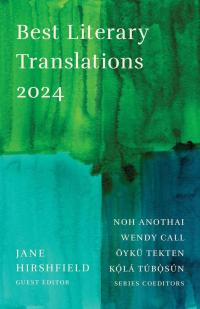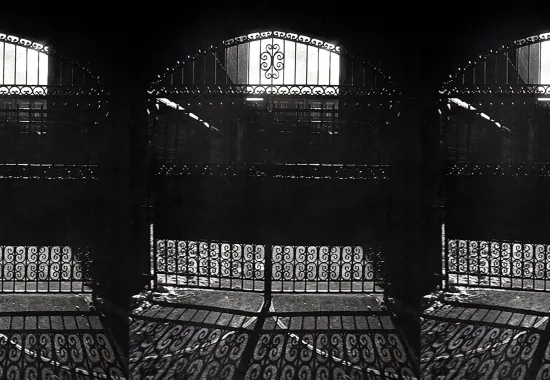A Review of Best Literary Translations 2024
What can a literary anthology do? Certainly it selects, evaluates, judges, and celebrates. Rarely does it claim to make an overt political intervention. Still more rarely might it be said to be operating at the cutting edge of its field. But this inaugural edition of Deep Vellum’s new annual anthology, Best Literary Translations, manages to do all of this and more. BLT 2024 at once advocates to a wider audience for the importance of publishing and reading literary translations, and makes important claims within the translation community about the practice’s possibilities, argued forcefully on political and aesthetic grounds.
 The problem this anthology responds to is a clear one, well-known within the international publishing community: the continued dearth of translations published in the United States. The famous “three percent” figure, referring to the proportion of translations published in the US annually in relation to endogenously English-language writing, has proven as stubborn as it is dismal. BLT places its commitment to this cause front and center. In materials from its call for submissions to its editorial introductions, it explicitly calls for more US-based literary journals to publish translations, even as it encourages them to do so by founding a place for these translations to be celebrated.
The problem this anthology responds to is a clear one, well-known within the international publishing community: the continued dearth of translations published in the United States. The famous “three percent” figure, referring to the proportion of translations published in the US annually in relation to endogenously English-language writing, has proven as stubborn as it is dismal. BLT places its commitment to this cause front and center. In materials from its call for submissions to its editorial introductions, it explicitly calls for more US-based literary journals to publish translations, even as it encourages them to do so by founding a place for these translations to be celebrated.
One certainly hopes that journals will respond to the chance to be anthologized by publishing more translations. Literary journals, often able to take greater financial risks than trade or even independent publishers, should already be sites of experimentation, pushing the status quo of literary publishing in new directions. The potential for translation to bring refreshing formal and aesthetic possibilities to a literary culture, through the introduction of poetic and narrative practices from diverse contexts, should be self-evident. (This capacity for formal and aesthetic innovation is evident throughout the remarkable poems, stories, nonfiction and hybrid works making up the anthology.) But the series co-editors—Noh Anothai, Wendy Call, Öykü Tekten, and Kọ́lá Túbọ̀sún—also make clear the important political stakes of their program. As they write in their introduction: “Best Literary Translations strives to be a curative to parochial thinking. We present voices from around the world, paying special attention to lesser-known literatures and languages. The guiding vision … is to offer a counterpoint to the xenophobia and racism that have marked the last decade—and, truly, the entire history—of this country.”
This commitment is joined by a marked anti-colonial agenda that appears not just in the writing suffusing the project, but in features of its organization. For example, each one of the four series editors is listed as contributing the (colossal) area specialties of one of the superregions of Asia, the Americas, the Middle East, and Africa. Notably absent from this list is Europe, the continent from which far and away the most translations into English are still produced. This is not to say that the anthology includes no translations from Europe whatsoever—we see writing from Bulgaria, Switzerland, and ancient Norway, among others—but its exclusion from the stated editorial focus sends the message that the translation community should look away from old centers of power. What kind of political program would it be to emphasize translation’s importance by recourse to endless retranslations of Dostoevsky, Flaubert, and Cervantes? Instead, the editors insist that translation into English focus on languages and cultures historically underrepresented in what little translated literature does trickle into the United States, thus insisting on translation’s possibility of presenting radically different perspectives on the world to Anglophone readers.
All are evidently convinced of not only translation’s possibility, but its necessity, and its capacity to celebrate the new.
In addition to its emphasis on the political role of translated literature, BLT doesn’t shy away from presenting translations that challenge on the technical and conceptual level. Alongside work that is comparatively classical in its approach, reproducing features of the source text in a manner so as to produce the illusion of the translator’s invisibility, we are treated to translations that explode this typical image. An illustrative example is the translation by Samson Allal titled “Hymn to Ra,” of materials from the tomb stela of King Wahankh Intef II, carved into stone over 4,000 years ago. The first stanza reads like many conservative translations of ancient texts do (simple in diction, solicitous of a god), but the second stanza blows this expectation away immediately, with words like “polychromatic” and “coruscating” instantly reaching into rare and specific corners of the English language. If this stanza doesn’t effect the turn of style clearly enough, the subsequent appearances of “origami,” “microchip,” and “hula hoop” are unmistakable for the attention they draw to the historical specificity of the translating language, its connection to the technological and material culture that surrounds it, and its irreducible distance of all this from the poem it translates. Of course, the simple language of the translation’s first stanza—“accept,” “me,” “you,” “go”—is a no less historically specific material than kevlar or obsidian. But by comparison, it has faded into the background, into an illusion of neutrality, even universality. The juxtapositional virtuosity of Samson Allal’s translation throws that illusion into question.
Of course, the vast, highly visible distance between Allal’s English and the hieroglyphs on Wahankh Intef II’s tomb is also present—to vastly different degrees, for sure, but without absolute difference in kind—between any two languages, and any duration between the production of a translation and its source text. These are the originary differences constitutive of all translation. They have been harped on by generations of unoriginal commentators who begin their tired remarks with eulogia to the impossibility of translation, especially of poetry, and its inevitable failure to create exactly the same poem out of different materials in a different time—something not only impossible, but nonsensical; it’s like lamenting the lack of right angles in a circle. This attitude about translation seems to pop up of its own accord, unprovoked, again and again, leading me to believe that there’s something about the process of learning to translate and write about translation that produces this mistake, as an inevitable step in the learning curve, an early illusion every translator learns to overcome. Thankfully, this particular fallacy is widely missing from the BLT anthology. Across dozens of editor’s and translator’s notes, we read a rich myriad of perspectives on the problems and possible solutions proper to the art. All are evidently convinced of not only translation’s possibility, but its necessity, and its capacity to celebrate the new. Reading the contents of this anthology, a line from one of its pieces kept coming to mind, by the Filipino writer Enrique Villasis, in Bernard Capinpin’s translation:
Newly molted, it descended to the waters. In its new life, it established itself in the sea. It left its apprehensions by the shore with its old skin.
BLT’s concentrated breadth of translation commentary, via the notes accompanying every translation, is one of the unique resources it provides to translators and readers curious about translation. (Though this reader must admit he sometimes found himself wishing for a few less “how-I-found-the-author” stories, a few less generalities about the practice, and a few more concrete details about the interesting features of the source texts in question.) In fact, beyond its admirable political commitments, and stated goal of incentivizing translation publication, the anthology is a remarkable compendium of resources, listed within its very pages, for translators and editors (current or would-be) of translations. It usually doesn’t make for exciting literary criticism to urge readers to consult a publication’s metadata, but in this case I have to. The contributor biographies, previous publications list, and longlist—that last of which includes translations selected from the submission pool by the series editors but not ultimately selected for inclusion by guest editor Jane Hirshfield—themselves make for important reading. They are the active, forward contingent of translators, editors (and writers, of course) whose interventions into the US literary landscape predate this anthology, and are what its publication aims to celebrate.
At some point in history, there existed a highest-ever number of human languages spoken. Regardless of how you count them, that apex is far in the past. In her Guest Editor’s Introduction, Hirshfield points out that “it’s said that the world loses a language every two weeks. With that language, a unique ecosystem of history and language vanishes also.” We live in a world where economic globalization, the pax americana (read: neocolonialism) and the centripetal forces of mass culture act like a homogenizing vortex on the linguistic, epistemological and cultural diversity of the world. One of the anthologized poems, “Our Village” by Tesfamariam Woldamarian, as translated from the Tigrinya by Charles Cantalupo and Menghis Samuel, seems to insist on this point: “You say, our village, but / Merely numbering the districts / In the province looks / Like counting pages in a book / That should be read instead.”
There is important work to be done to combat this loss, and certainly not all of it is to be found in the sphere of literary production. But publishing, anthologizing—and most of all, reading—translations is an important step. Nobody can learn to read in all the languages of this world. But by reading and celebrating the work of translators—those dedicated scholar-poets who rise to the diverse ethical, aesthetic, and political challenges literary translation poses—we can take important steps towards enshrining its literary production of this world in all its diversity.
Recommended
Clark O Lucky Day
A Review of Jim Reese's Coming to a Neighborhood Near You






